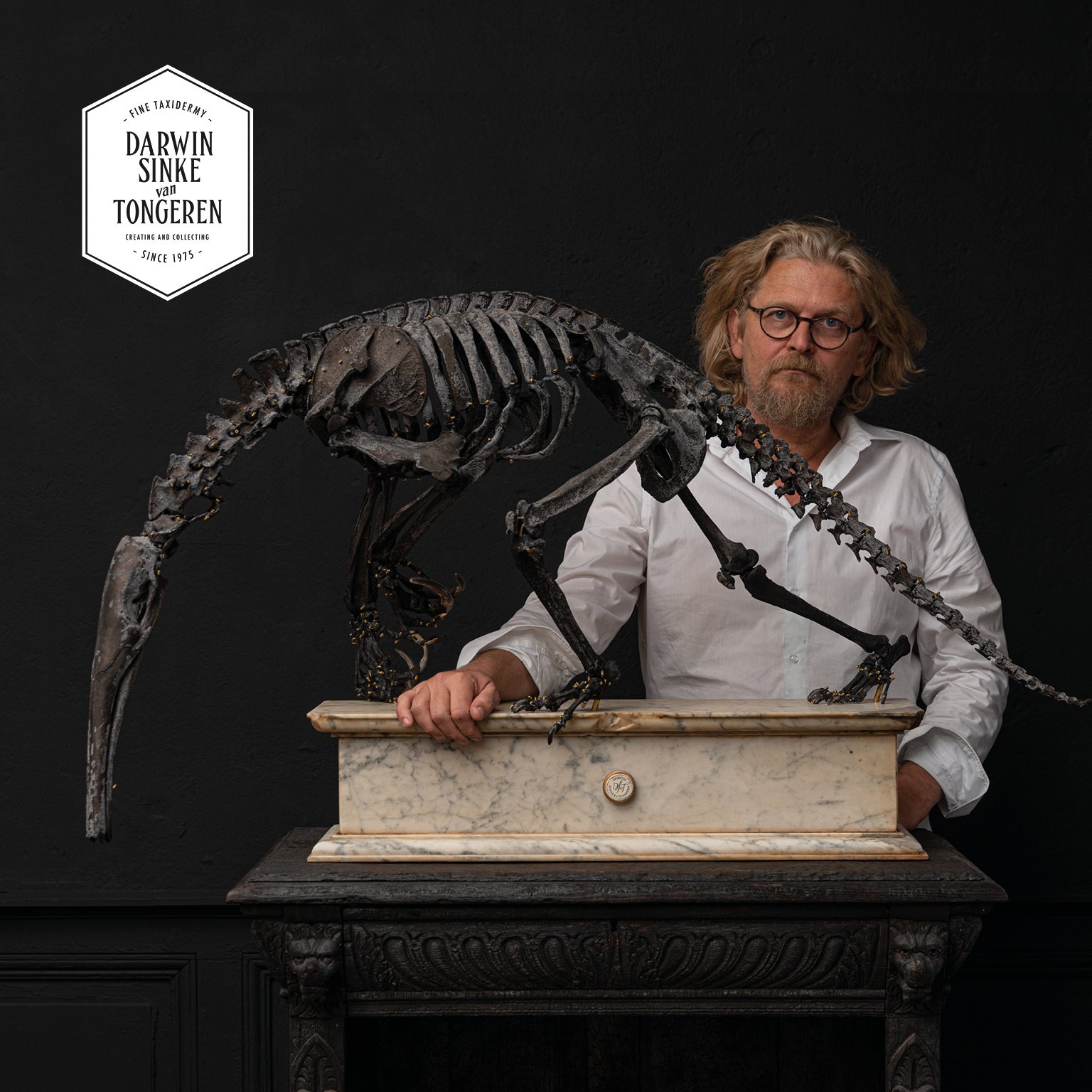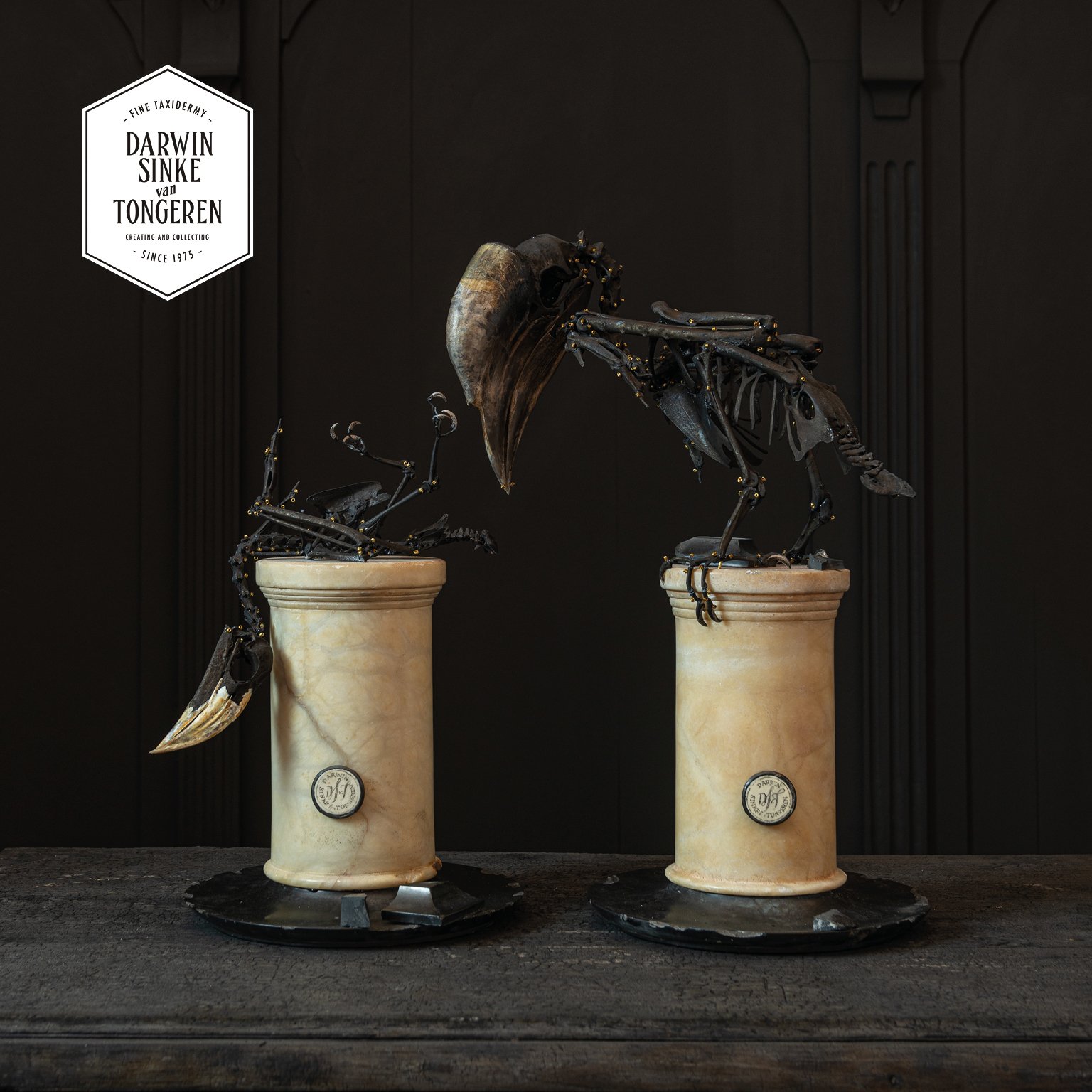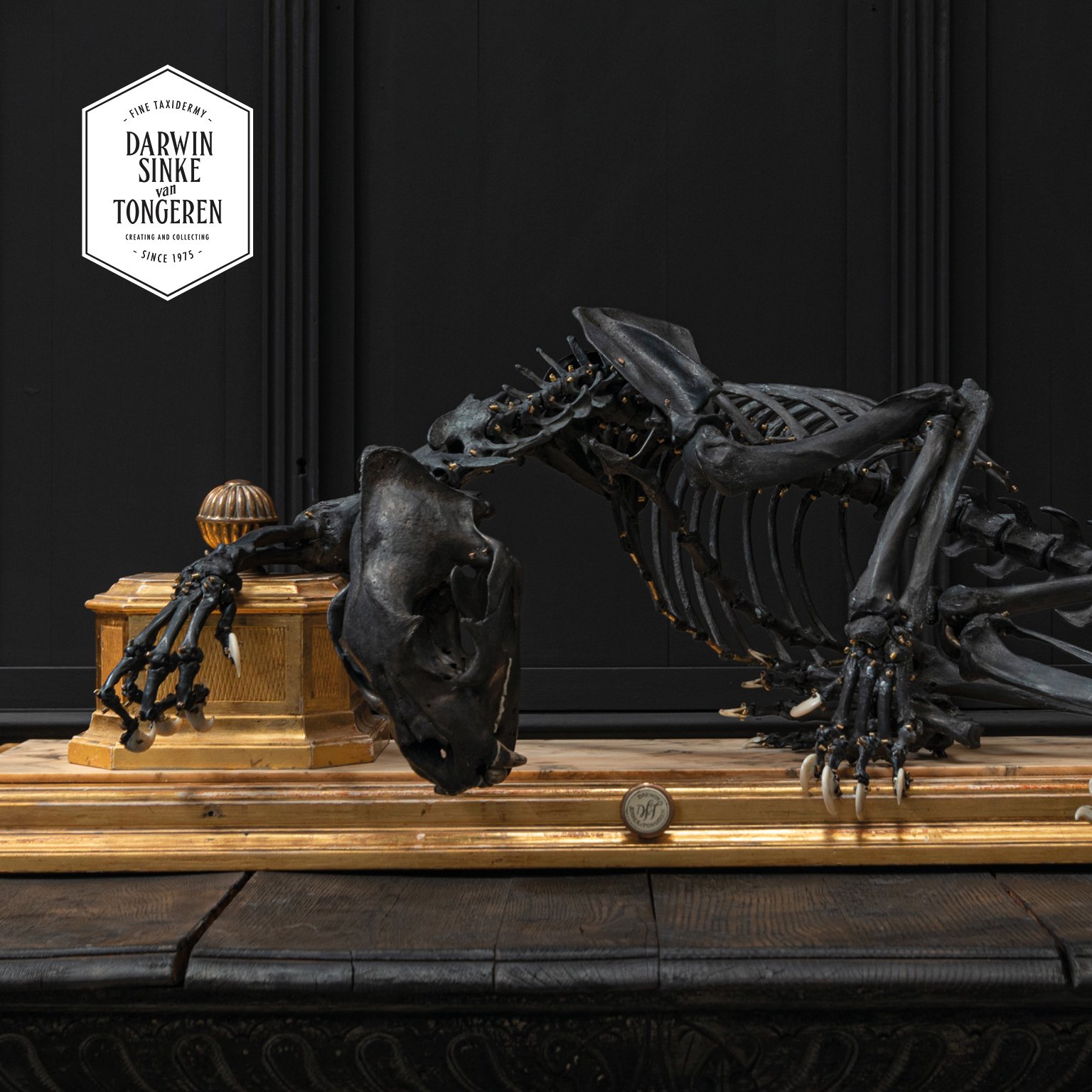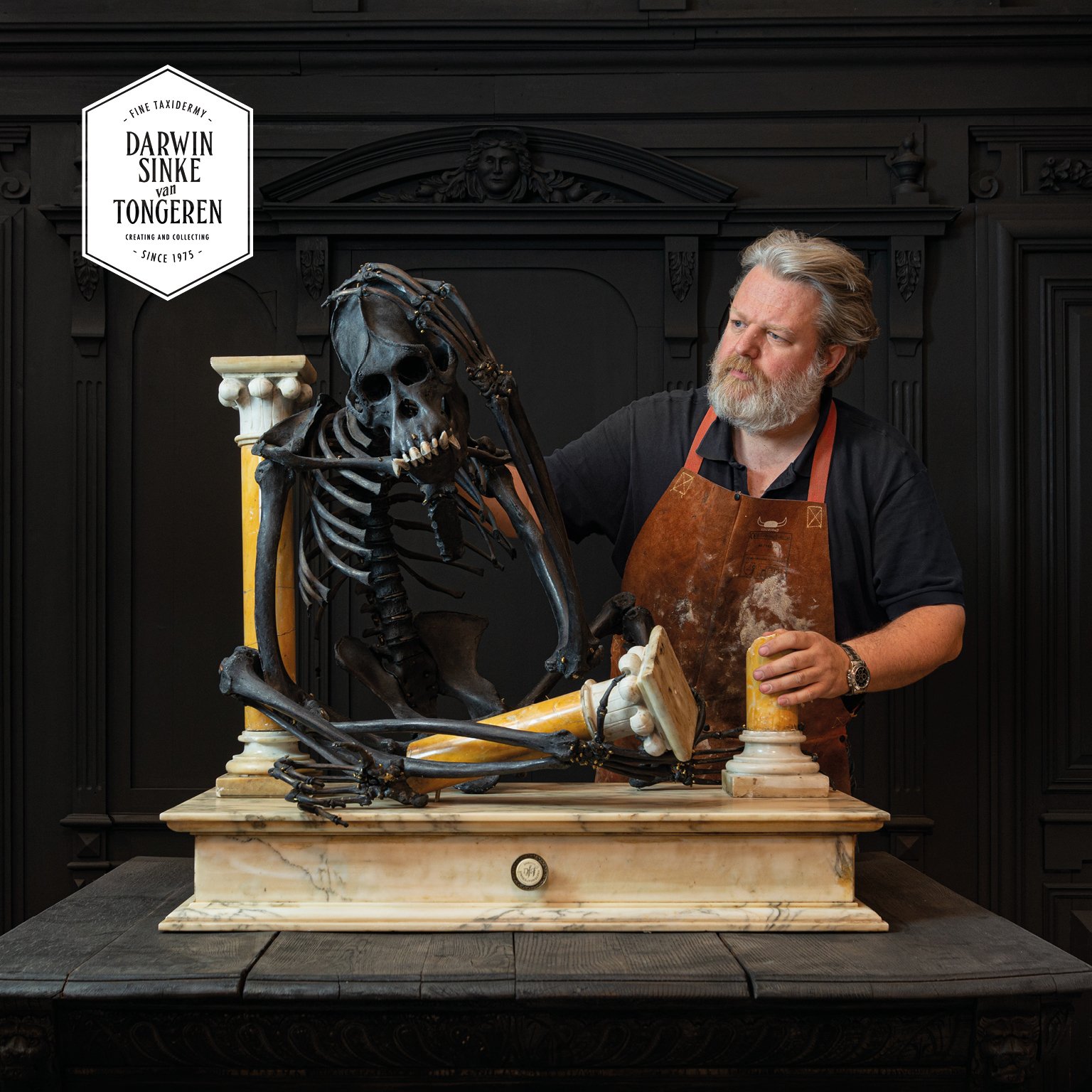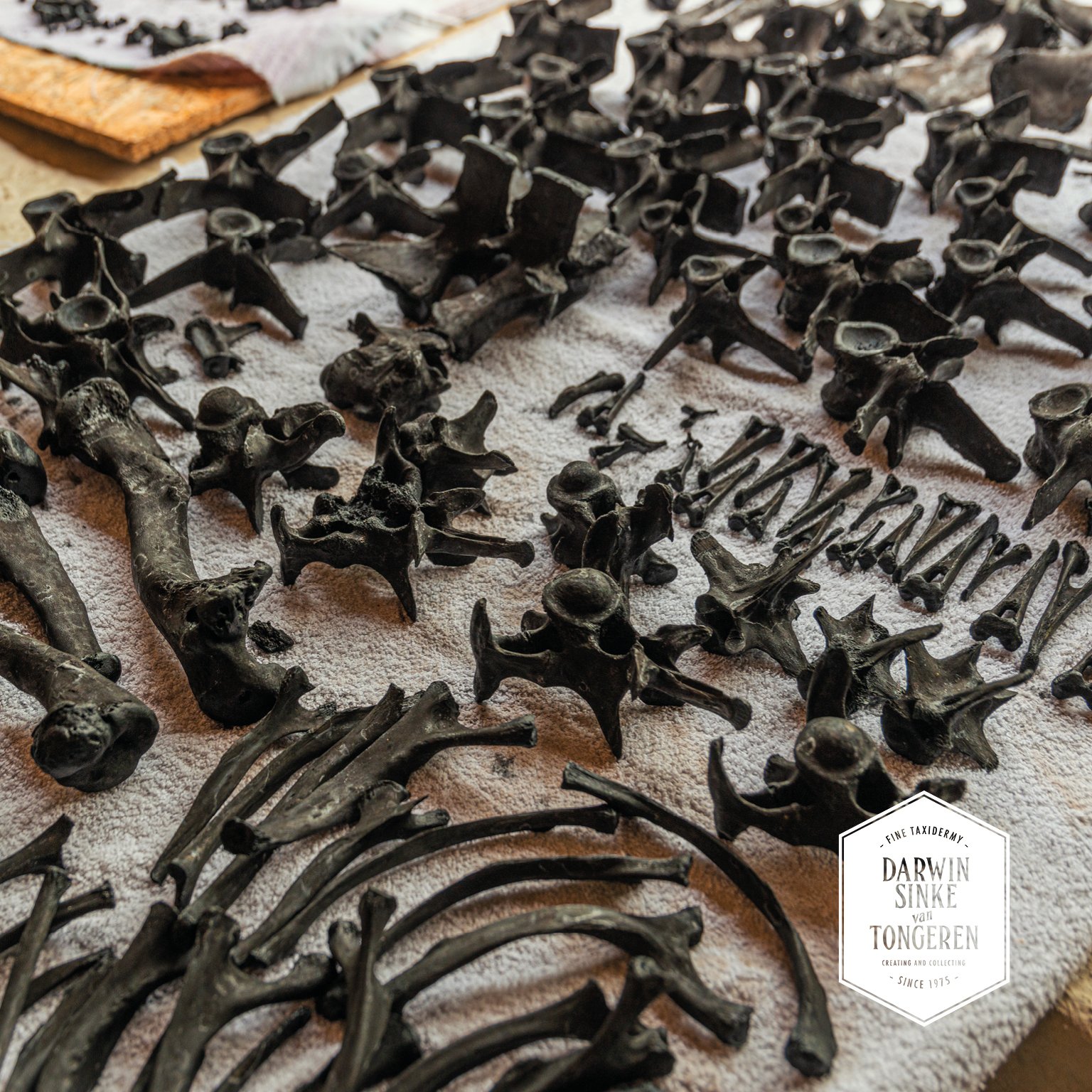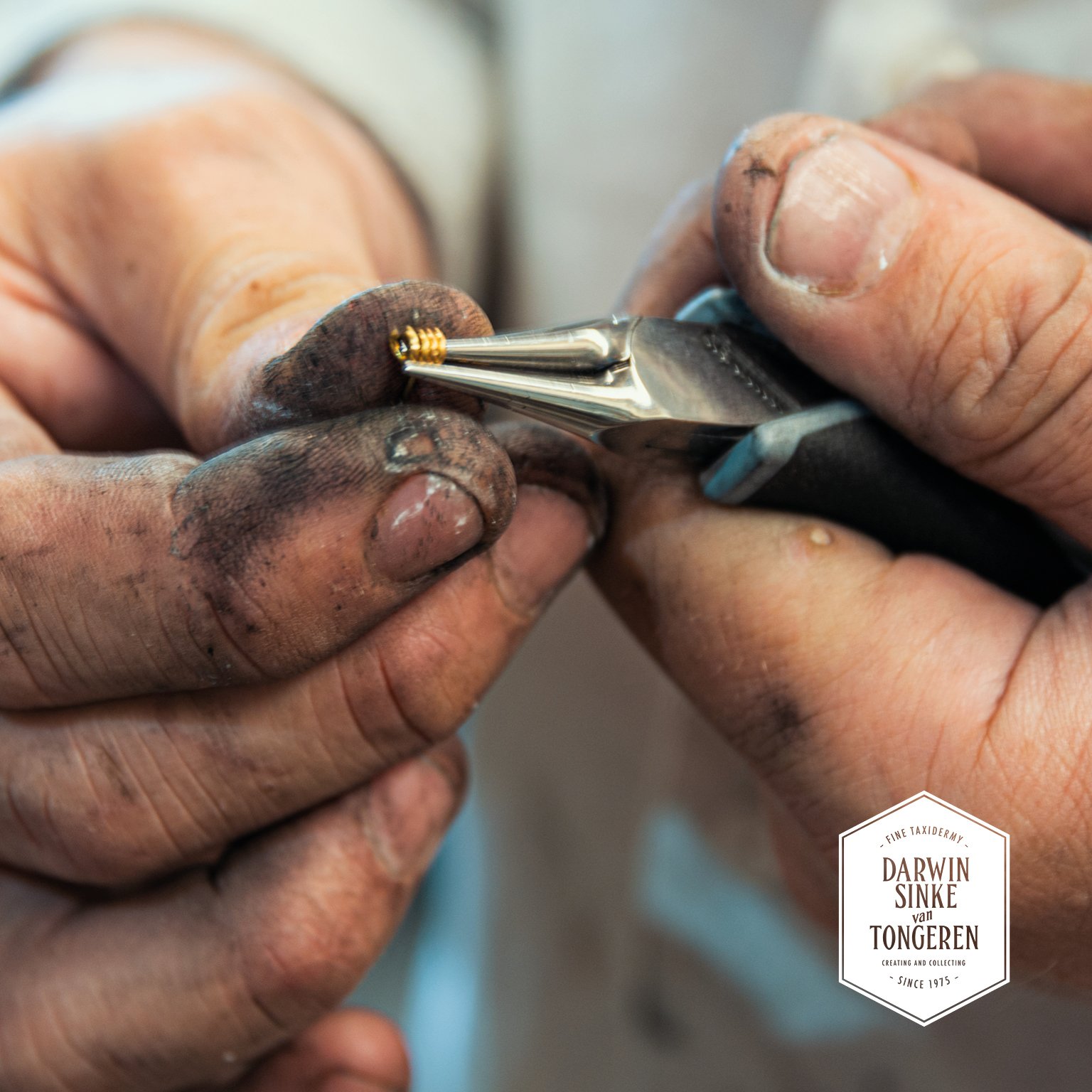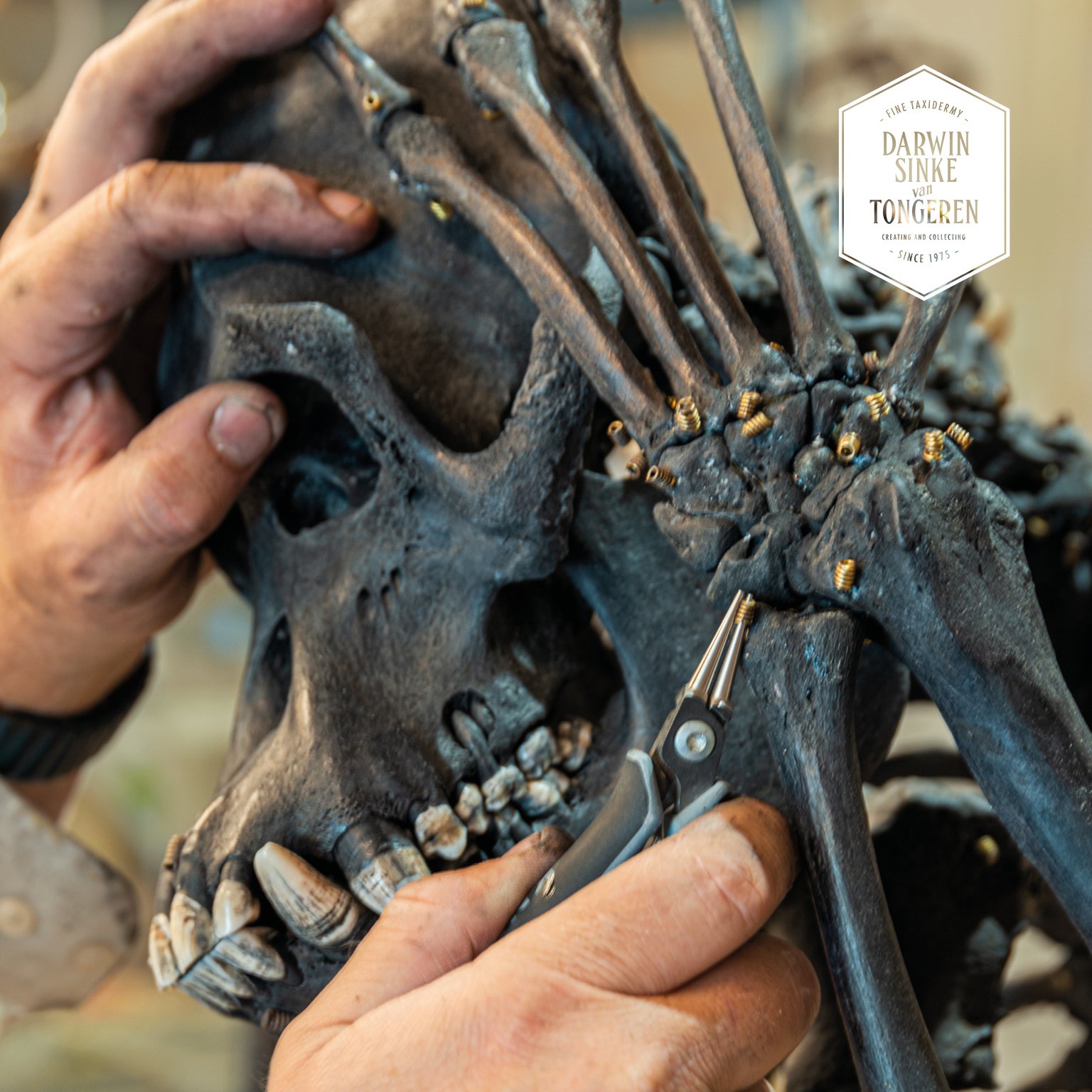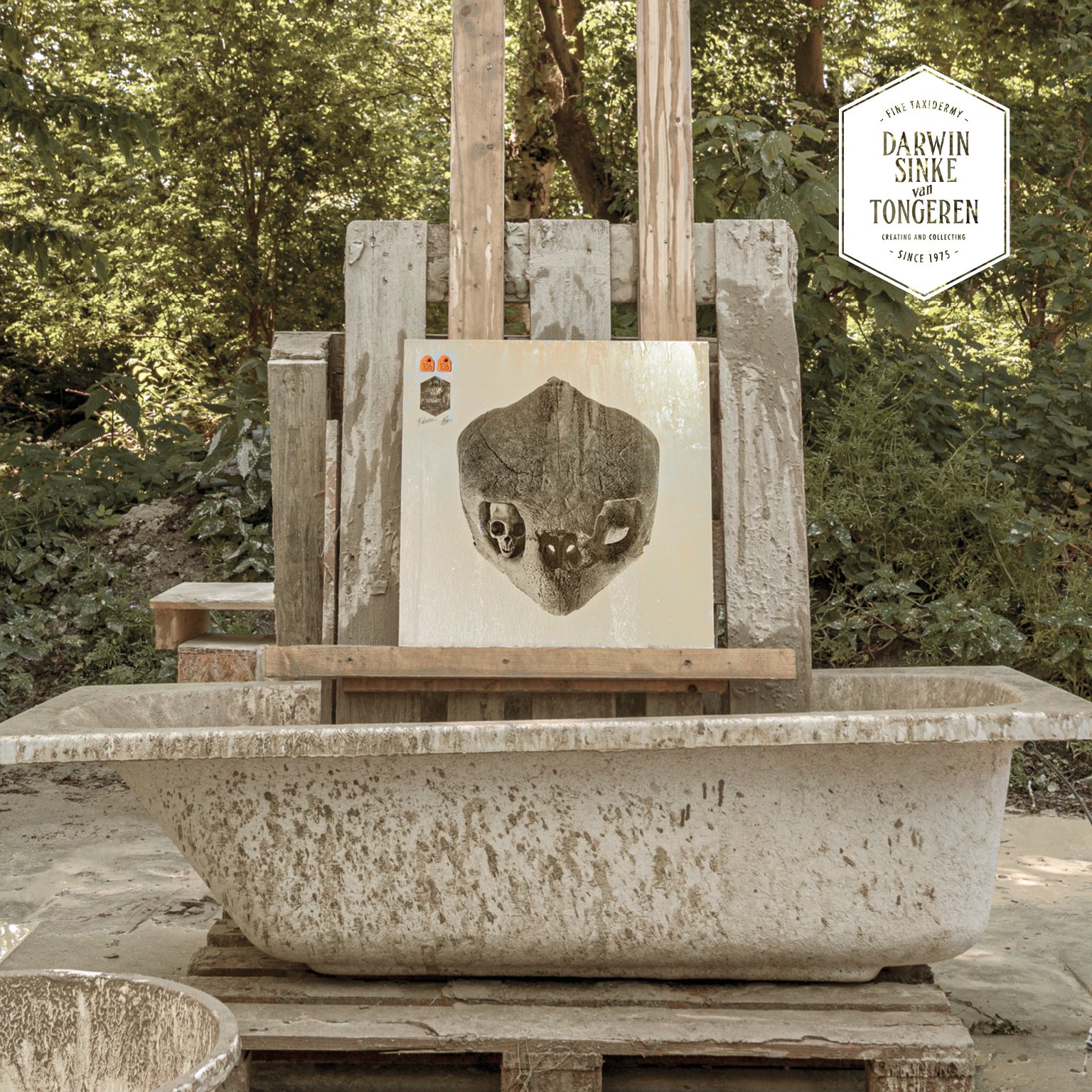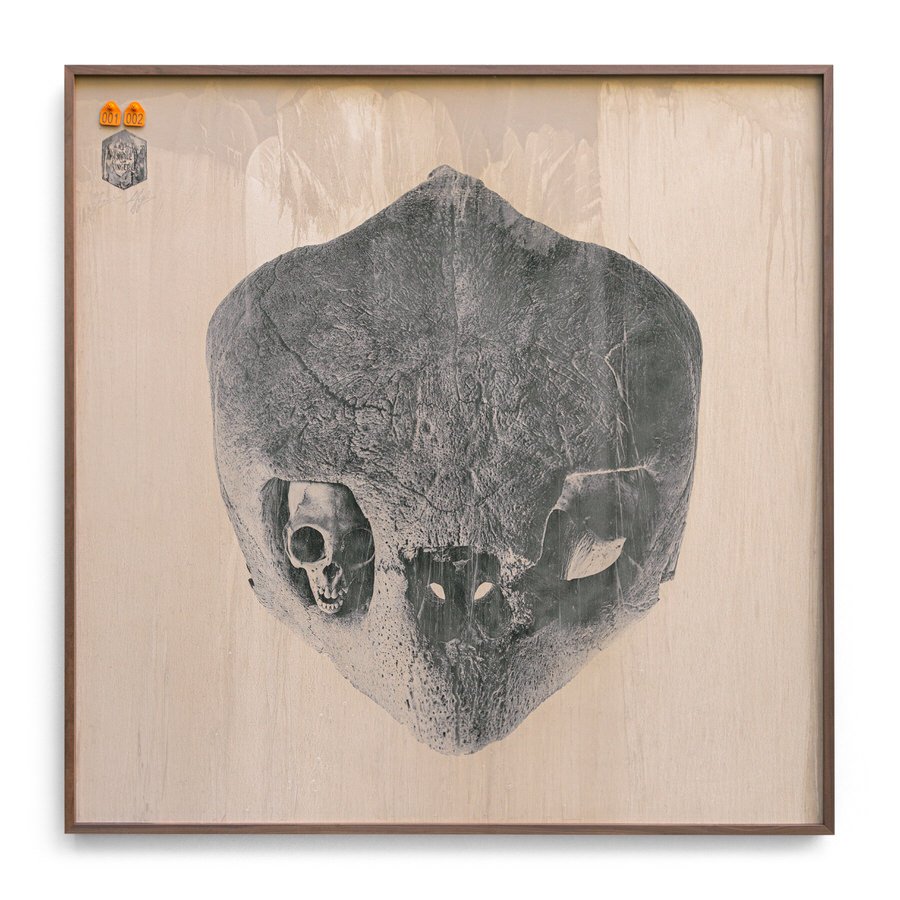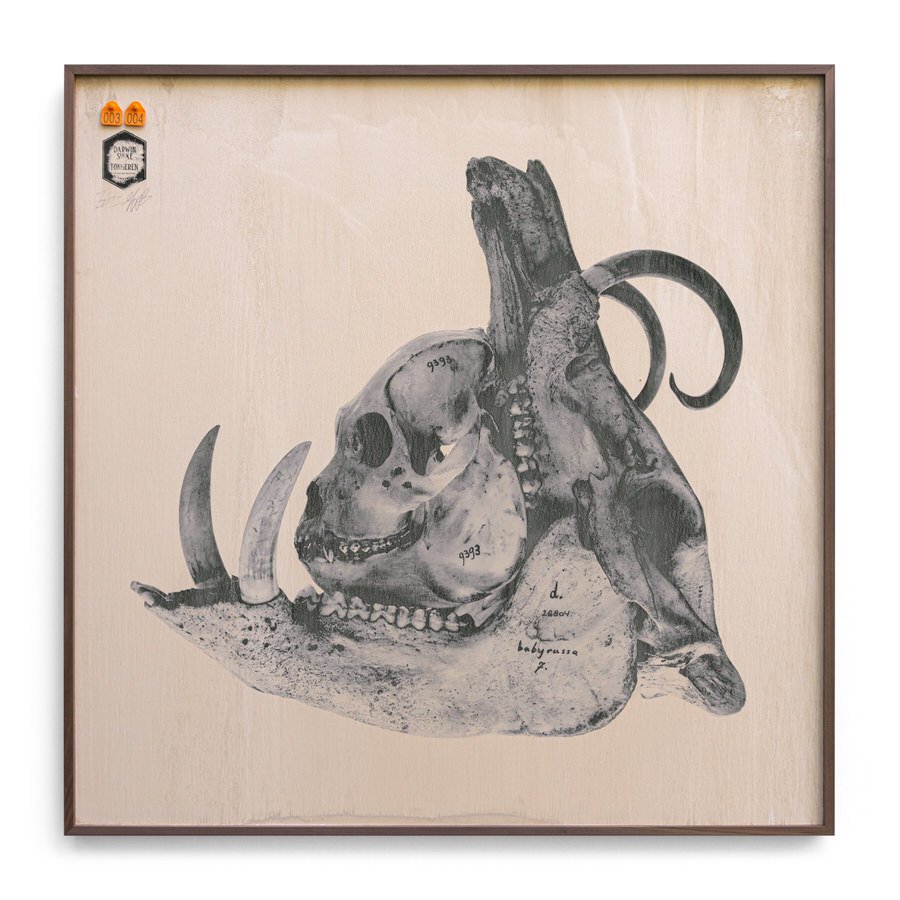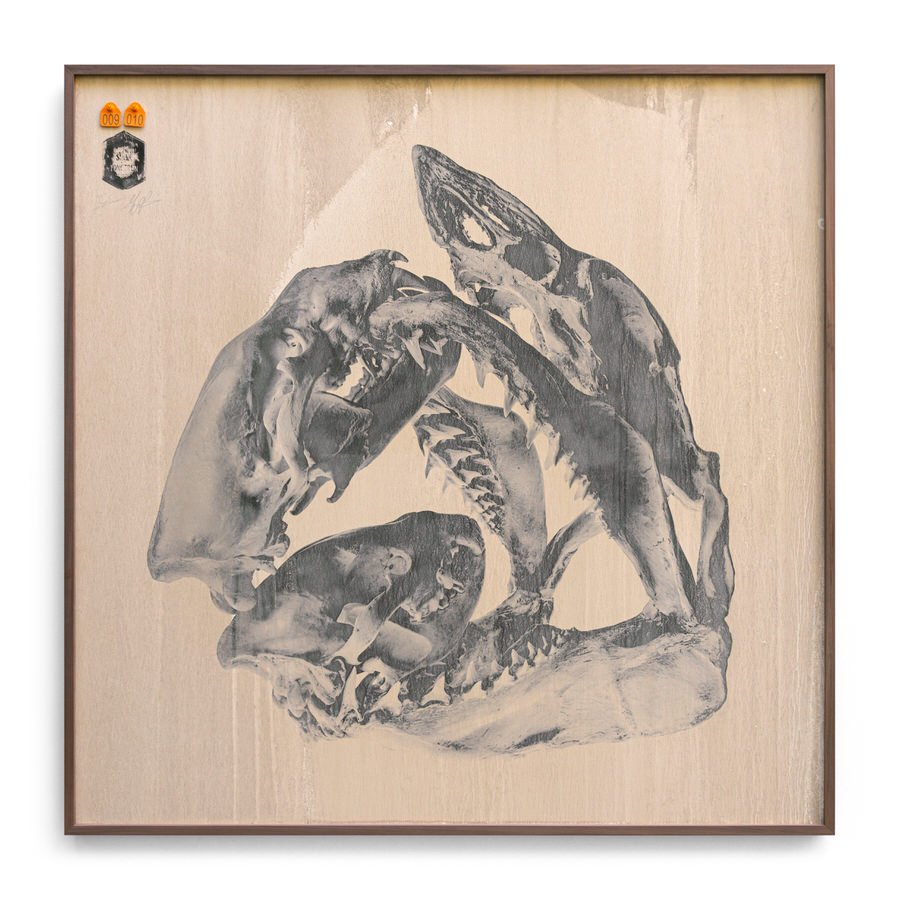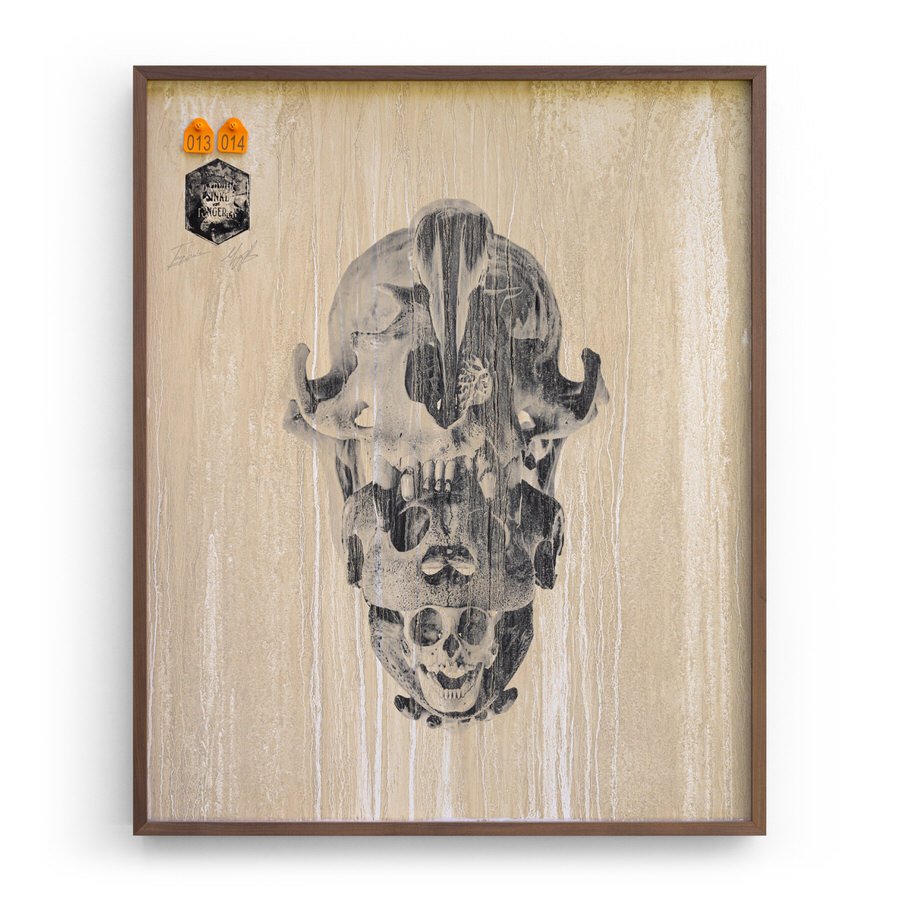THE REMAINS OF THE 1900 LONDON CONVENTION
SKELETON COLLECTION
‘The Remains’ is a series of animal skeletons based on ancient marble sculptures. The collection is an homage to the beauty of the remains of the creatures, which we argue was – and is – our responsibility as humans to protect. Most of the animals shown are on the endangered species list and some of them are species on the edge of extinction.
As well as the skeleton collection, there is also a new multimedia photo-collection, for which we collaborated with Naturalis, the renowned Museum of Natural History in Leiden. These predominantly black-and-white art prints feature the skulls and bones of endangered species in a highly contemporary way.
This exhibition is an indictment against 122 years of international politics. It focuses on the first multilateral treaty on wildlife by European colonial powers that attempted to protect wild animals. However, the agreements that resulted from the convention were signed but never ratified by the attending countries. Ironically, 120 years of ‘animal protection’ has in fact marked the period where human activity has pushed biodiversity to the edge.
PLEASE NOTE:
All skeletons came from animals that were born in captivity in legitimate breeding programmes and all died of natural causes. They have the required paperwork that enables them to be sold legally. Sales are designed to help breeding programmes, with 15% of each sale donated directly to them.
NORTHERN GIRAFFE
(Giraffa camelopardalis)
Status: vulnerable
Price: € 60.000,- excl. VAT
Dimensions:
L: 157 cm W: 100 cm H: 227 cm
L: 61.8 in. W: 39.4 in. H: 89.4 in.
Approximately 5000 Northern Giraffes are left in the world. In nature that is. The Northern Giraffe is the tallest giraffe species and therefor the tallest animal in the world. Even a young giraffe, like this one is over 2 meter. But less and less space is left for these pretty creatures to live in.
BORNEAN ORANGUTAN
(Pongo pygmaeus)
Status: critically endangered
Price: € 150.000,- excl. VAT
Dimensions:
L: 90 cm W: 46 cm H: 82 cm
L: 35.43 in. W: 18.1 in. H: 32.3 in.
Over the last 20 years 55% of the habitat of the Bornean Orangutan has vanished. No wonder it is critically endangered. Only one step away from extinction. Reason enough to save this animal. But instead, the deforestation goes on in an even more rapid tempo. The Orangutan work in our collection is by far the rarest.
It comes with official documents stating it was raised in a Dutch zoo.
Currently on display at Art Zoo Museum
Note: Not available for the US
BLACK JAGUAR
(Panthera onca)
Status: near threatened
Price: € 90.000,- excl. VAT
Dimensions:
L: 116 cm W: 54 cm H: 50 cm
L: 45.7 in. W: 21.3 in. H: 19.7 in.
Athough the jaguar is not the largest cat species it is the one with the strongest muscles. It’s the ‘body builder’ among the Panthera family. A Black Jaguar is actually the same as a normal jaguar but have excess black pigments. That’s called Melanism. Jaguar numbers have been declining since 1990. And a Black Jaguar is even more rare.
Note: Not available for the US
CATTLE & CONCRETE
ART PRINT COLLECTION
BONNET MACAQUE
(Macaca radiata)
Status: vulnerable
Price: € 25.000,- excl. VAT
Dimensions:
L: 45 cm W: 23 cm H: 50 cm
L: 17.7 in. W: 9 in. H: 19.7 in.
This Macaque from India is the monkey tourist would typically meet at temples and other historic sites. In your memory they were there in large numbers. In fact, this species is rapidly declining. More than 70% of the population vanished over the last 20 years. One reason is the invading Resus Macaque that is much more aggressive. They steal the spots for getting free tourist food from the more friendly Bonnet.
Currently on display at Art Zoo Museum
DE BRAZZA’S MONKEY
(Cercopithecus neglectus)
Status: LC
Price: € 25.000,- excl. VAT
Dimensions:
L: 45 cm W: 23 cm H: 55 cm
L: 17.7 in. W: 9 in. H: 21.65 in.
De Brazza’s Monkey is an old-world monkey from the central parts of Africa. Although the species is not critical threatened at the moment, it has been added to the species survival plan by AZA (Association of Zoos and Aquariums) to proactively prevent the need for reactive conservation in the future. In our opinion De Brazza’s Monkeys are among the most beautiful monkey species
Currently on display at Art Zoo Museum
SIAMESE CROCODILE SKULLS
(Crocodylus siamensis)
Status: Critically Endangered
Price: € 6.000,- each or € 10.000,- as a set
excl. VAT
Dimensions:
L: 60 cm W: 28 cm H: 30 cm
L: 23.6 in. W: 11 in. H: 11.8 in.
The Siamese Crocodile has a similar look as the Saltwater crocodile. But while the ‘Salty’ is doing pretty good the Siamese Crocodile is doing much worse. Rice farmers compete for the wetlands and commercial hunters are after their beautiful skin. Nowadays the siamese crocodile is being held in breeding facilities more and more. But in the wild the numbers are still declining.
Currently on display at Art Zoo Museum
Note: Not available for the US
ABDIM’S STORK
(Ciconia abdimii)
Status: population decreasing
Price: € 12.500,- excl. VAT
Dimensions:
L: 40 cm W: 24 cm H: 70 cm
L: 16 in. W: 9 in. H: 27.6 in.
The Abdim’s Stork is one of the smallest storks. It is widespread on the African continent. Although the numbers are declining it is doing pretty good. The reason for this could be that the African people protect these birds because they believe that it is a harbinger of rain and good luck!
Currently on display at Art Zoo Museum
SNAPPING TURTLE
(Chelydra serpentina)
Status: population decreasing
Price: SOLD
Dimensions:
L: 40 cm W: 23 cm H: 46 cm
L: 16 in. W: 9 in. H: 18 in.
This monstrous looking creature only lives in the United States. It has a clay shaped beak that nothing can escape from. In fact, it has not much to fear from any other animal than men.
The numbers are not only declining because of loss of habitat but also because of the roads going through their habitats. Great numbers are lost because of roadkill each year.
MOUSTACHED TAMARIN &
GOLDEN-HANDED TAMARIN
(Saguinus mystax & Saguinus midas)
Status: population decreasing
Price: SOLD
Dimensions:
L: 78 cm W: 47 cm H: 152 cm
L: 30.7 in. W: 18.5 in. H: 60 in.
Although the numbers are decreasing there is hope for tamarins. This is because of the fact that they are so adaptive to change. They can acclimate well to changes in environmental conditions and also to human settlements that appear around them. Looking at a skeleton of these tamarin species shows how much it looks like us. Doesn’t it?
GREAT WHITE PELICAN
(Pelecanus onocrotalus)
Status: Unknown
Price: € 27.500,- excl. VAT
Dimensions:
L: 48 cm W: 37 cm H: 94 cm
L: 18.9 in. W: 14.6 in. H: 37 in.
A large Pelican that can be found in Europe, Africa and Asia. This species is protected under so many laws that it is doing pretty well. But this was not always the case. Tobacco bags were made of the pelican pouch. Their skin was turned into leather. Their shit was used as a fertiliser. Ethiopian people thought they tasted great and the Chinese extracted traditional medicine from some parts of the animal.
Currently on display at Art Zoo Museum
JAPANESE SPIDER CRAB
(Macrocheira kaempferi)
Status: population decreasing
Price: € 35.000,- excl. VAT
Dimensions:
L: 180 cm D: 34 cm H: 113 cm
L: 70.9 in. D: 13.4 in. H: 44.5 in.
The largest crustaceans on earth. The Japanese Spider Crab. They can grow up to 3.8 meters width. There numbers are declining in recent years, although they are not commercially fished because of the fact they live too deep. The Japanese Spider Crab is part of our collection because they have an exoskeleton.
Currently on display at Art Zoo Museum
BLACK-CASQUED HORNBILL &
AFRICAN PIED HORNBILL
(Ceratogymna atrat & Lophoceros fasciatus)
Status: unknown
Price: € 22.000,- (as a set) excl. VAT
Dimensions:
L: 23 cm W: 23 cm H: 47 cm
L: 9 in. W: 9 in. H: 18.5 in.
Black-casqued Hornbill is not protected at all. But we should. Their numbers are declining and this is mainly because African farmers and poachers shoot them from the trees. Such a waste of such a beautiful creature.
EMU
(Dromaius novaehollandiae)
Status: population stable
Price: € 30.000,- ecl. VAT
Dimensions:
L: 113 cm W: 73 cm H: 95 cm
L: 44.5 in. W: 28.7 in. H: 37.4 in.
The second largest bird in the world lives on the plains of Australia. The population of Tasmania is now extinct. Once they were the enemy of men during the Great Emu wars in 1932. Over 20.000 emus were shot by employed soldiers. But the emus ‘won’! And it took the Australian government 67 years to agree on the Environment Protection and Diversity conservation Act that protects them.
ROAN ANTELOPE
(Hippotragus equinus)
Status: unknown
Price: € 45.000,- excl. VAT
Dimensions:
L: 138 cm W: 110 cm H: 227 cm
L: 54.3 in. W: 43.3 in. H: 89.4 in.
Although extinct in two African countries the Roan Antelope is not in danger as a species at the moment. Large numbers can still be found in many African countries. Thanks to wildlife conservation and breeding programs their numbers grew in the past. Today though numbers are going down again. What a pity.
GREATER RHEA
(Rhea americana)
Status: vulnerable
Price: € 17.500,- excl. VAT
Dimensions:
L: 83 cm W: 39 cm H: 103 cm
L: 32.7 in. W: 15.3 in. H: 40.5 in.
Rheas in South America were hunted a lot for their meat and skins. And when this ended in 1980 the deforestation took flight. Cows occupied lots of their habitats. Fortunately, Greater Rheas are held as pets throughout the world. So extinction is not on the agenda at the moment.
CHEETAH
(Acinonyx jubatus)
Status: vulnerable
Price: € 78.000,- excl. VAT
Dimensions:
L: 97 cm W: 45 cm H: 120 cm
L: 38.2 in. W: 17.7 in. H: 47.24 in.
Cheetahs are not doing well at all. They are hunted by farmers, lost 90% of their habitats and to make things worse they have some sort of error in their DNA that makes it very hard to recover from their decline. Although many breeding programs in the world are working on it the success is not there yet. Some experts even believe they will go extinct pretty soon
Currently on display at Art Zoo Museum
Note: Not available for the US
GIANT ANTEATER
(Myrmecophaga tridactyla)
Status: vulnerable
Price: € 90.000,- excl. VAT
Dimensions:
L: 130 cm W: 40 cm H: 68 cm
L: 51.2 in. W: 15.7 in. H: 26.7 in.
The Giant Anteater is extinct in some parts of South America. The skeleton of this animal shows what a magnificent creature it is. His bones are very heavy for an animal this size. An armor almost. In fact, while working on these bones it reminded us of the bones of a rhino. It probably needs them to push itself through the dense forests. And than that beautiful vacuum cleaners shaped head. It is truly a one-of-a-kind species.
Currently on display at Art Zoo Museum



